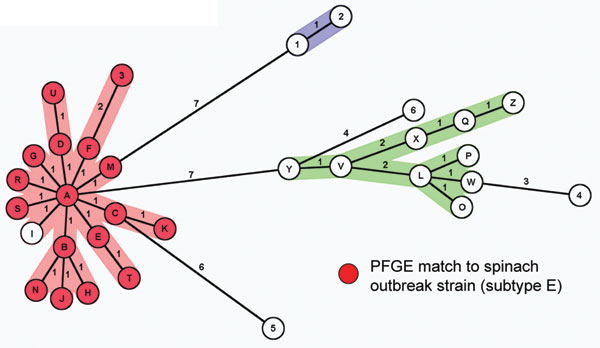Volume 13, Number 12—December 2007
Dispatch
Escherichia coli O157:H7 in Feral Swine near Spinach Fields and Cattle, Central California Coast1
Figure 2

Figure 2. Minimum spanning tree analysis of multilocus variable number tandem repeat analysis (MLVA) data of 76 Escherichia coli O157:H7 strains typed from 47 samples compared with the spinach-related outbreak strain (subtype E). A categorical coefficient and the BURST priority rule of the highest number of single-locus changes were used for the clustering (Bionumerics software version 4.601, Applied Maths, Austin, TX, USA). Circles representing unique MLVA types are designated by an alphanumeric value (Table 2). Numbers between circles represent summed tandem-repeat differences between MLVA types (10). The shaded areas (red, green, and blue) denote genetically related clusters with MLVA differences <3. Red circles indicate types comprising isolates that were indistinguishable from the spinach-related outbreak strain (subtype E) by pulsed-field gel electrophoresis (PFGE).
References
- Cornick NA, Helgerson AF. Transmission and infectious dose of Escherichia coli O157:H7 in swine. Appl Environ Microbiol. 2004;70:5331–5. DOIPubMedGoogle Scholar
- Feder I, Wallace FM, Gray JT, Fratamico P, Fedorka-Cray PJ, Pearce RA, Isolation of Escherichia coli O157:H7 from intact colon fecal samples of swine. Emerg Infect Dis. 2003;9:380–3.PubMedGoogle Scholar
- Rice DH, Hancock DD, Besser TE. Faecal culture of wild animals for Escherichia coli O157:H7. Vet Rec. 2003;152:82–3.PubMedGoogle Scholar
- Sargeant JM, Hafer DJ, Gillespie JR, Oberst RD, Flood SJ. Prevalence of Escherichia coli O157:H7 in white-tailed deer sharing rangeland with cattle. J Am Vet Med Assoc. 1999;215:792–4.PubMedGoogle Scholar
- Wahlstrom H, Tysen E, Olsson-Engvall E, Brandstrom B, Eriksson E, Morner T, Survey of Campylobacter species, VTEC O157 and Salmonella species in Swedish wildlife. Vet Rec. 2003;153:74–80.PubMedGoogle Scholar
- Centers for Disease Control and Prevention. Ongoing multistate outbreak of Escherichia coli serotype O157:H7 infections associated with consumption of fresh spinach—United States, September 2006. MMWR Morb Mortal Wkly Rep. 2006;55:1045–6.PubMedGoogle Scholar
- California Department of Health Services and US Food and Drug Administration. Investigation of an Escherichia coli O157:H7 outbreak associated with Dole pre-packaged spinach. 2007;1–50 [cited 2007 Apr 17]. Available from http://www.dhs.ca.gov/ps/fdb/html/food/envinvrpt.htm
- Sweitzer RA, Gardner IA, van Vuren D, Boyce WM, Waithman JD. Estimating sizes of wild pig populations in the north and central coast regions of California. J Wildl Manage. 2000;64:531–43. DOIGoogle Scholar
- Himathongkham S, Dodd ML, Yee JK, Lau DK, Bryant RG, Badoiu AS, Optimal enrichment conditions and recirculating immunomagnetic separation (RIMS) for enhanced detection and recovery of low levels of Escherichia coli O157:H7 from fresh leafy produce and surface water. J Food Prot. 2007;70. In press.PubMedGoogle Scholar
- Cooley M, Carychao D, Crawford-Miksza L, Jay MT, Myers C, Rose C, Incidence and tracking of Escherichia coli O157:H7 in a major produce production region in California. PLoS One. 2007;2:e1159. DOIPubMedGoogle Scholar
- Ribot EM, Fair MA, Gautom DN, Cameron SB, Hunter B, Swaminathan B, Standardization of pulsed-field gel electrophoresis protocols for the subtyping of Escherichia coli O157:H7, Salmonella, and Shigella for PulseNet. Foodborne Pathog Dis. 2006;3:59–67. DOIPubMedGoogle Scholar
- Hyytia-Trees E, Smole SC, Fields PA, Swaminathan B, Ribot EM. Second generation subtyping: a proposed PulseNet protocol for multiple-locus variable-number tandem repeat analysis of Shiga toxin-producing Escherichia coli O157 (STEC O157). Foodborne Pathog Dis. 2006;3:118–31. DOIPubMedGoogle Scholar
- Keys C, Kemper S, Keim P. Highly diverse variable number tandem repeat loci in the E. coli O157:H7 and O55:H7 genomes for high-resolution molecular typing. J Appl Microbiol. 2005;98:928–40. DOIPubMedGoogle Scholar
- Atwill ER, Sweitzer RA, Pereira MG, Gardner IA, van Vuren D, Boyce WM. Prevalence of and associated risk factors for shedding Cryptosporidium parvum oocysts and Giardia cysts within feral pig populations in California. Appl Environ Microbiol. 1997;63:3946–9.PubMedGoogle Scholar
- Waithman JD, Sweitzer RA, Van Vuren D, Drew JD, Brinkhaus AJ, Gardner IA, Range expansion, population sizes, and management of wild pigs in California. J Wildl Manage. 1999;63:298–308. DOIGoogle Scholar
1This work was presented in part as a poster at the 107th General Meeting of the American Society for Microbiology, Toronto, Ontario, Canada, May 24, 2007.